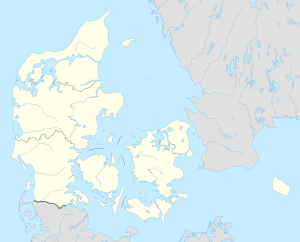Studstrup power plant
| Studstrup power plant | |||
|---|---|---|---|
| location | |||
|
|
|||
| Coordinates | 56 ° 15 '5 " N , 10 ° 20' 40" E | ||
| country | Denmark | ||
| Data | |||
| Type | Thermal power station | ||
| Primary energy | Fossil energy , bioenergy | ||
| fuel | Wood pellets , straw | ||
| power | Electricity: 700 MW District heating: 910 MW |
||
| operator | Ørsted | ||
| Start of operations | 1968 | ||
| turbine |
Extraction condensation turbines |
||
| Chimney height | 190 m | ||
| Energy fed in 2006 | District heating: 9,090 TJ Electricity: 3,340 GWh |
||
| was standing | 2012 | ||
The Studstrup power plant is a Danish power plant owned by the Ørsted energy group . It is located on Kalø Vig north of Arhus and was commissioned in 1968.
technology
| block | combustible material |
net power |
District heating output |
commissioning acceptance |
breastfeeding interpretation |
|---|---|---|---|---|---|
| 1 | ? | ? | ? | 1968 | 1998 |
| 2 | ? | ? | ? | ? | 1999 |
| 3 | Wood pellets, straw | 350 MW | 455 MW | 1984 | |
| 4th | Coal, straw, oil | 350 MW | 455 MW | 1985 | 2016 |
The power plant is built as a combined heat and power plant, which means that it is operated in combined heat and power and, in addition to electricity for the general electricity network, also generates 90% of the district heating in the city of Arhus. About 130 people work in the power plant. Initially, only oil and coal were used for firing. Later up to 15% biomass in the form of straw was added.
A 12 MW gas turbine on site means that the power plant can be black-started . Mineral oil can be used as fuel for this.
Now there are only power plant units 3 and 4, which were built in the mid-1980s. Each of the two blocks had a maximum net output of 350 megawatts (MW) and a maximum district heating output of 455 MW. At full load, 120 tons of coal or 73 tons of mineral oil were used every hour. Between 2014 and 2016, Unit 3 was converted to the exclusive use of biomass, Unit 4 was shut down. On October 10, 2016, the Studstrup power plant was switched from coal to wood pellets. Since 2019, straw has been added to the wood pellets again, which is a waste material in the Danish fields.
The extraction condensation turbines are charged with steam at a temperature of 540 ° C and a pressure of 250 bar. The exhaust gases from both blocks are emitted via a common 190 m high chimney with two individual exhaust pipes inside. The power plant does not have a cooling tower, but the waste heat from the condensers is dissipated to the sea water of Kalø Vig by means of continuous cooling.
Block 3 is connected to the 150 kV high-voltage network and block 4 was connected to the 400 kV extra-high voltage network. The connection to the district heating network is made via two pairs of pipes with a pipe diameter of 2 m each. In order to be able to decouple electricity generation and district heating feed-in, the power plant has a district heating storage facility with a volume of 30,000 m³ of water. The district heating storage facility was expanded in 2015 by two electric boilers in order to be able to generate district heating from wind power in the event of excess electricity.
The power plant had a coal store for 800,000 tons of coal, which corresponded to the normal consumption of seven months. The power plant also had an oil storage facility consisting of seven tanks with a volume of 25,000 m³ each. In the course of the switch to wood pellets, a silo for 65,000 tons of pellets was built. The silo is 43 m high and has a diameter of 70 m.
See also
literature
- DONG Energy A / S (Ed.): The Studstrupværket . CHP plans. (English, online [accessed October 13, 2012] brochure).
Web links
- Studstrup Power Station. DONG Energy A / S, accessed October 13, 2012 .
Individual evidence
- ↑ a b c Green district heating for Denmark's second largest city. In: www.orsted.com. October 10, 2016, accessed on May 24, 2020 .
- ^ Studstrup Power Station to use straw as fuel again. In: www.orsted.com. May 29, 2019, accessed on May 24, 2020 .

